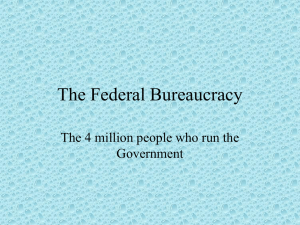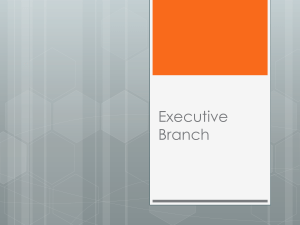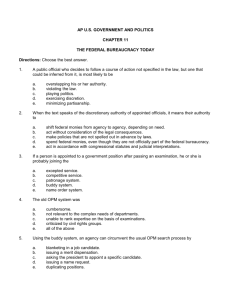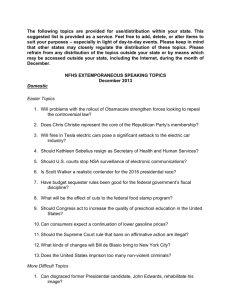“Iron Triangle”
advertisement
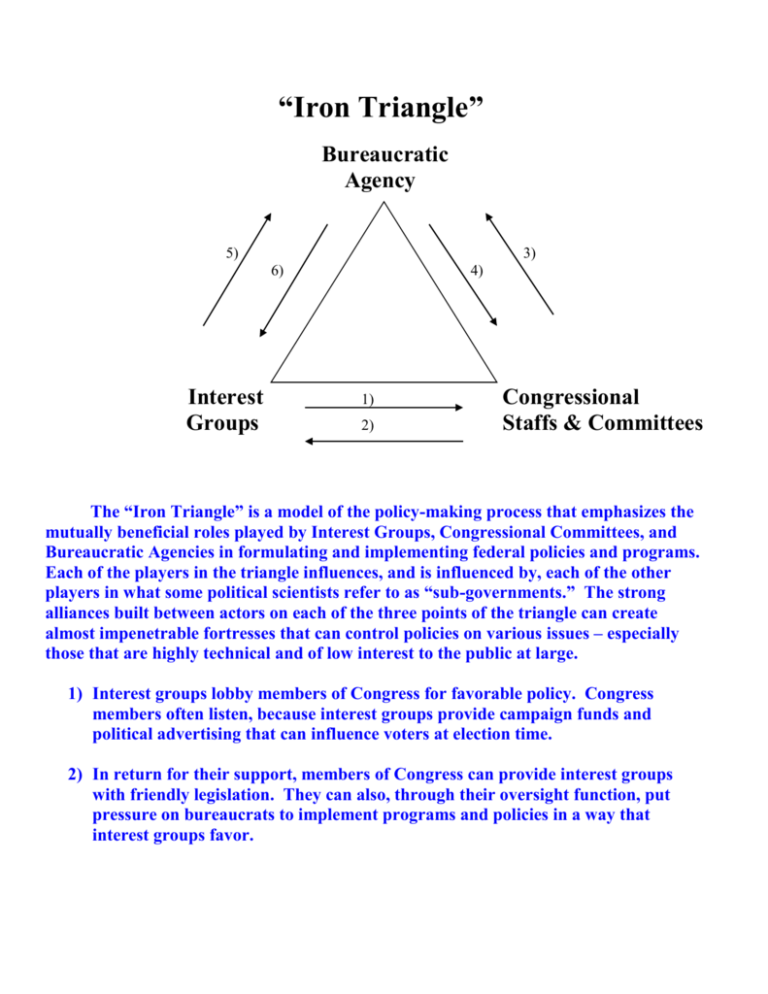
“Iron Triangle” Bureaucratic Agency 5) 3) 6) Interest Groups 4) 1) 2) Congressional Staffs & Committees The “Iron Triangle” is a model of the policy-making process that emphasizes the mutually beneficial roles played by Interest Groups, Congressional Committees, and Bureaucratic Agencies in formulating and implementing federal policies and programs. Each of the players in the triangle influences, and is influenced by, each of the other players in what some political scientists refer to as “sub-governments.” The strong alliances built between actors on each of the three points of the triangle can create almost impenetrable fortresses that can control policies on various issues – especially those that are highly technical and of low interest to the public at large. 1) Interest groups lobby members of Congress for favorable policy. Congress members often listen, because interest groups provide campaign funds and political advertising that can influence voters at election time. 2) In return for their support, members of Congress can provide interest groups with friendly legislation. They can also, through their oversight function, put pressure on bureaucrats to implement programs and policies in a way that interest groups favor. 3) Members of Congress make budgetary decisions that directly impact the funding that bureaucratic agencies receive from year to year. Congress members can use this “power of the purse” to influence how bureaucrats do their jobs. They also, through their oversight power, can investigate and call out bureaucratic agencies that aren’t doing what Congress wants them to. 4) Bureaucrats can choose to execute policies in a way that is favorable to members of Congress who control their budgets and oversee their operations. 5) Interest groups will often lobby bureaucrats directly for favorable implementation of policies that affect their members. Interest groups can also rally public support or disfavor for bureaucrats and their agencies based on their performance. 6) Bureaucrats, knowing that interest groups often have the ear of key members of Congress, can implement policies and programs in ways that please interest groups. Keeping interest groups happy, often keeps key members of Congress happy. Noticeably absent from this model of policy-making and implementation is any role played by the President of the United States. There are two reasons for this: first, the electoral process and the 22nd Amendment combine to make presidents somewhat transient. Even the best presidents are only around for eight years. In addition, the president, by the complex nature of his/her job, focuses primarily on the big picture, and not on the minute details of individual policies. “Issue Network” 2) 1) Mass Media Interest Groups 5) bB Bureaucratic Agency 3) Policy Experts (University think tanks, Policy institutes, etc.) Congressional Staffs & Committees 4) Another model of the policy-making process is the “Issue Network.” This model probably better approximates how policy is made on higher-profile issues. The “Iron Triangle” model probably best illustrates how policies are created and carried out on highly technical, low-profile issues of which the public is largely ignorant. The Issue Network model assumes that an issue has been brought to the attention of the public and that policy-formulation is taking place in the public forum. 1) As Wilson notes in Chapter 12, one of the key functions of the mass media is the role that it plays as “Gatekeeper” of the public agenda. In other words, the issues that the media focuses on tend to be the ones that the public is most interested in. This important agenda-setting function puts the media in a position to help shape new policies by keeping them on the front burner. Although much of the media leans in a more liberal direction, there are certainly many powerful conservative voices (FOX news, Rush Limbaugh, etc.) who also weigh in regularly on important policy issues. 2) Interest groups are constantly in search of favorable policy, and on any highly publicized issue, there will almost certainly be interest groups lined up on both sides of the issue. These groups will try to influence public perceptions of the issue by advertising their point of view to the public through mass emails, TV and radio ads, sending their spokesmen out to appear on political talk shows, etc.. In addition, they will lobby members of Congress directly to influence both their committee work in actually drafting legislation, and their votes on bills once they are presented to the floor. 3) Policy experts at university think tanks and independent policy institutes conduct studies on various policy alternatives and report their findings to both the public and the Congress. Although these policy experts will often claim to be non-partisan actors with access to special technical information and analytical expertise, in reality, the results of their studies will often be skewed, depending on the organization, in either a more liberal or a more conservative direction. Interest groups and members of Congress will often use the findings of such policy experts to support their positions on the issue at hand. 4) It is in committees in Congress that the actual details of legislation are drafted and approved. Members and their staffs do not operate in a vacuum, and will often react to what they see in the media, what they hear from interest groups, and the expert analysis provided to them by policy experts. It should be remembered that most members are mindful of how any vote they take may impact their chances of getting re-elected and/or of someday running for higher office. 5) In the eye of the hurricane created by the various actors in the Issue Network are the bureaucratic agencies that will eventually have to implement any new policies that are created. Bureaucrats, too, do not operate in a vacuum and are not immune from the competing forces that battle to create policy in the first place. Bureaucrats are wary of offending entrenched interests or creating bad publicity that can harm their standing with members of Congress who control their budgets and who, through their oversight function, can call bureaucrats on the carpet to testify about what they are doing and why they are doing it. It should be noted once again, that in the Issue Network model, as in the Iron triangle model above that it is assumed that presidents do not often have much influence on the detailed process of domestic policy making. The complexities of his job and the transient nature of his office keep him from having much of an impact on exactly how policies are written and implemented. While his administration can give an overall direction (more liberal for Democrats or more conservative for Republicans) to the types of policies that are made and implemented, rarely does a president exert much control over the actual policy-making apparatus.

